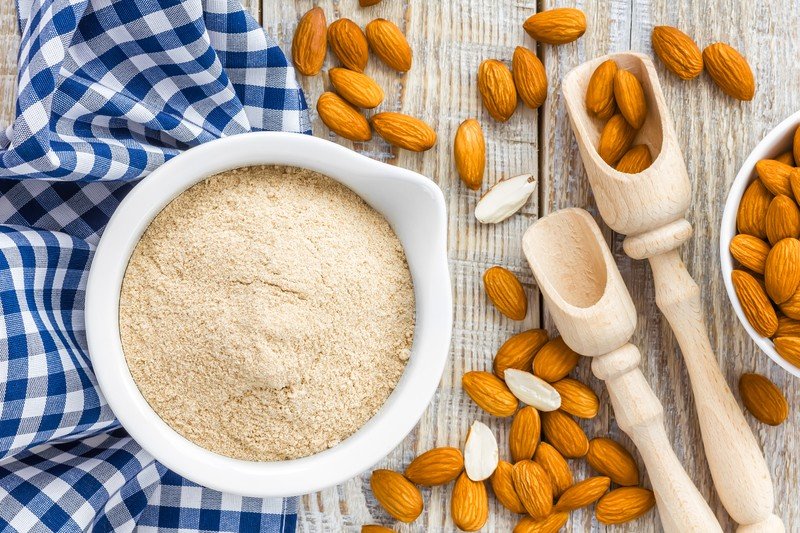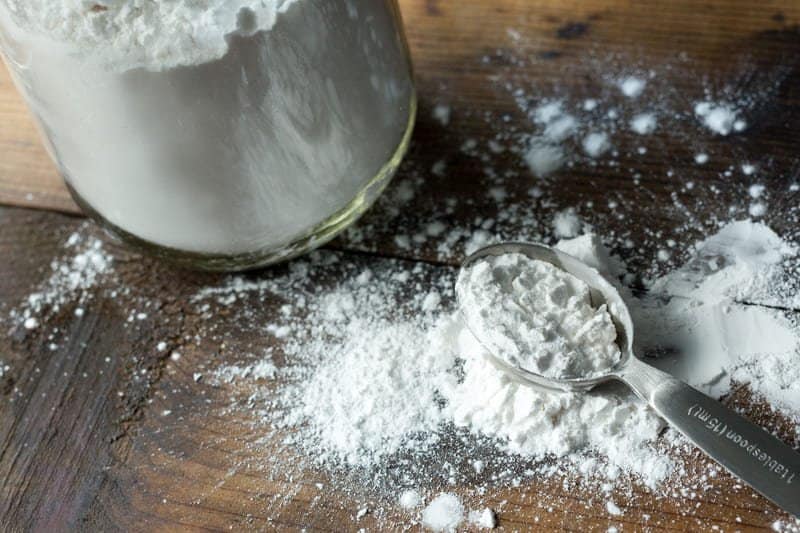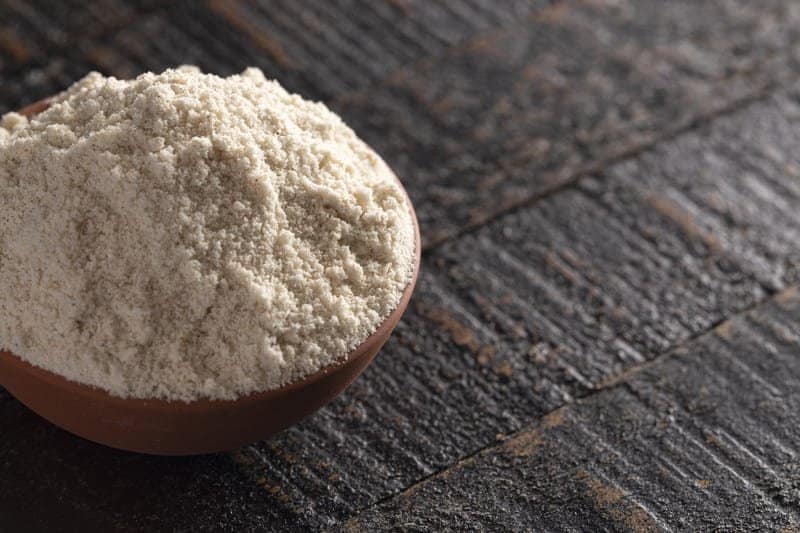Sweet rice flour is a form of flour that is made from sticky rice and it is a common substitute for wheat flour. It also goes by the name ‘glutinous rice flour’ because of its texture and its consistency.
Despite the name, this glutinous sweet rice flour is actually gluten free and it is a great alternative that can mimic the properties of gluten.
Also despite what the name might suggest, this flour is not actually very sweet and it instead has a mild only delicate sweetness.
Sweet rice flour has 16% more iron than usual flour in just 1 cup, so it has great health benefits.
It also has a high starch content and can be used in batters, sweet bakes and it is also great for thickening sauces.
Sweet rice flour is often used as the main flour in gluten free breads or treats like biscotti. The starch content also stops your dish from becoming too crumbly and will leave it chewy when cooked, so it is a good mimic of actual gluten.
Top 10 Sweet Rice Flour Substitutes
There are lots of great substitutes for sweet rice flour. It is essential to know that not every substitute will produce the exact same result as sweet rice flour would. But if you are looking for a good alternative, check out the list below:
1. Almond flour

It also has a slightly nutty and mild sweet flavour. Almond flour is the best alternative for sweet rice flour when it comes to baking heavy goods, such as cakes or dense desserts.
When using almond flour as a replacement for sweet rice flour, the ratio does not need to be altered and it is a 1:1 replacement.
However almond flour is not as sticky as sweet rice flour so you may need to add additional water or liquid to your dish to act as a binding agent.
2. Arrowroot

Arrowroot is a typical gluten free flour and it is also grain free. It also has a slightly sweet taste but overall arrowroot has a rather neutral taste so it will not overpower the flavour of your dish.
Like sweet rice flour, arrowroot is a good thickener in recipes, especially for sauces.
However, arrowroot is only a suitable alternative for sweet rice flour if you combine it with another gluten free flour.
When replacing 1 cup of sweet rice flour, you should use 2/3 cup of arrowroot flour and combine it with 1/3 cup of another gluten free flour.
You should also use 1 tablespoon of water for every 2 tablespoons of arrowroot to make sure your dish is not dry or crumbly.
3. Brown rice flour

When replacing sweet rice flour, brown rice flour must be paired with another gluten free flour that is very starchy.
To replace 1 cup of sweet rice flour, add 2/3 cup of brown rice flour and 1/3 of a starch such as tapioca or cornstarch.
4. Cassava flour
Cassava flour, which is made from a root vegetable, is another great replacement for sweet rice flour.
Again it is gluten free and it has a neutral flavour. Cassava flour also has a fine powdery consistency, which makes it an ideal alternative for desserts.
Because of the consistency of cassava flour, it needs to be combined with another gluten free flour. To replace 1 cup of sweet rice flour, use 2/3 cup of cornflour and combine it with 1/3 cup of another gluten free flour.
5. Cornflour

Cornflour can be used as a good thickener in sauces and fillings and it is the best alternative for dishes that require this.
Like with most substitutes, it is essential to combine cornflour with another gluten free flour. When replacing 1 cup of sweet rice flour, use 2/3 cup of cornflour and combine it with 1/3 cup of another gluten free flour.
6. Potato starch

For a sweet rice flour substitute, potato starch is the best alternative when it comes to making a batter or a coating.
To use it as an alternative, potato starch needs to be mixed with another flour. When you are replacing 1 cup of sweet rice flour, use 2/3 cup of potato starch and 1/3 cup of a different gluten free flour.
Although sweet rice flour is not very sweet, it is sweeter than potato starch so you may wish to add a little bit of sugar to your dish to compensate for this.
7. Sorghum flour

Sorghum flour has a similar sweet flavour to sweet rice flour but it is not as sticky so you may have to increase the amount of water or liquid in your dish to help act as a binding agent.
When looking for a substitute for sweet rice flour, sorghum flour is the best alternative when it comes to cookies, but can also be used in other bakes.
When using sorghum flour as a replacement for sweet rice flour, the ratio does not need to be altered and it is a 1:1 replacement.
However you do need to add 1 tablespoon at a time to get the right consistency otherwise the mixture can become quite congealed.
8. Tapioca flour

It has a sweet flavour and is very starchy, like most gluten free flours. Tapioca flour also absorbs water well much like sweet rice flour so using this as an alternative will result in a similar slightly chewy texture.
When looking for an alternative to sweet rice flour, tapioca flour is the best substitute when it comes to baking, especially for chewy desserts like brownies.
It is a great thickener for sauces and fillings and it can be used at a 1:1 replacement ratio for sweet rice flour in this instance.
However, if you are using tapioca flour in baking it is good to mix it with another flour so it does not become too thick.
Replace 1 cup of sweet rice flour with 2/3 cup of tapioca flour and then 1/3 cup of another gluten free flour.
Although sweet rice flour is not very sweet, it is, as with potato starch, sweeter than tapioca flour so you may wish to add a little bit of sugar to your dish to compensate for this.
9. White rice flour
A common assumption is that white rice flour and sweet rice flour are the same ingredient. But although sweet rice flour is made from white rice, it is not the same as white rice flour.
White rice flour is made from medium to long grain rice which is not so sticky, but sweet rice flour is made from short grain rice.
Despite this white rice flour is still a suitable alternative for sweet rice flour. This gluten free flour has a fine light texture and will lead to tender spongey bakes.
Like brown rice flour, it is not as sweet as sweet rice flour so you need to add a sweet starch to the flour to compensate for this.
When you replace 1 cup of sweet rice flour, use 2/3 cup of white rice flour and 1/3 of a sweet starch, like arrowroot or tapioca.
10. Gluten free flour mix

Simply mix together different gluten free flours, whether it be white rice flour, tapioca flour or even arrowroot, to create your substitute.
Most gluten free flours will have the same taste and texture so this is a good substitute. The ratio does not need to be altered and it is a 1:1 replacement.
How should I store sweet rice flour?
Sweet rice flour does not spoil quickly or easily. Make sure that you store it in a cool dark place, like a cupboard or a larder, in an airtight container and it should remain usable for 6 months.
What are the issues with using sweet rice flour in baking?
Sweet rice flour may give you your desired texture, but if you use too much of it, it can be an issue for your dish.
Using too much sweet rice flour will create a lot of moisture in your dish and it can cause your dish to become wet and chewy, especially with cakes it can become quite stodgy.
Also sweet rice flour has a distinct and sweet flavour, so if you use too much of it, it can ruin the taste of your dish. You must use sweet rice flour in moderation or the taste can become overwhelming.
What is the difference between rice flour and sweet rice flour?
Sweet rice flour is not the same as rice flour. Rice flour is a lot more common in supermarkets and it is also gluten free.
Despite the name similarity, these ingredients are very different and would not be suitable substitutes for each other.
Sweet rice flour is ground from sticky rice and results in a light powdery flour that is both soft and sticky.
On the other hand rice flour is ground from medium to long grain rice and can often be quite gritty.
It is light and it may give your dish a nice crunch. Rice flour also is not good at absorbing water.
Is there a sweet rice flour substitute for making Mochi?
Sweet rice flour can also be called ‘mochiko flour’ as it is the usual flour used in mochi, which is a Japanese rice cake.
Mochi is a traditional and popular Japanese dessert made with sweet rice flour. Each of the above substitutes would work as long as you have sticky glutinous rice.
Can I make sweet rice flour?
If none of the above alternatives appeal to you, you can instead attempt to make sweet rice flour if you don’t have it on hand.
To do this you need short grain glutinous white rice, which is often used to make sushi. 1 cup of short grain rice should result in 2 cups of sweet rice flour.
Just follow this step-by-step:
- Rinse and drain your rice of starch until the water runs clearly.
- Soak your rice in water for at least 8 hours. It should expand to double its size.
- Strain the rice well and make sure the water is clear.
- Use a food processor to grind the rice into a fine powder.
- Sift the powder to remove any chunks and add them to the food processor until fine.



